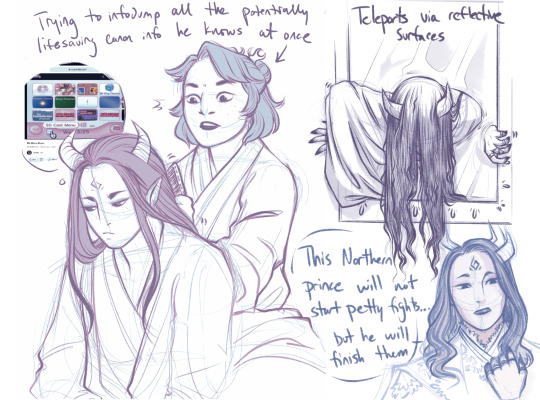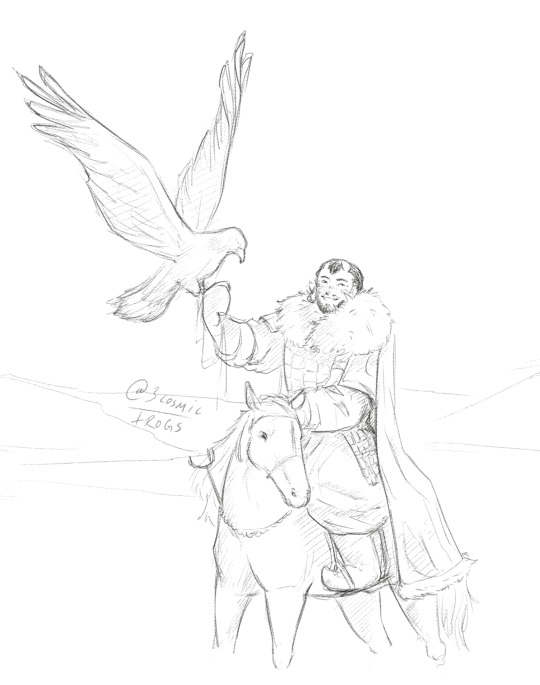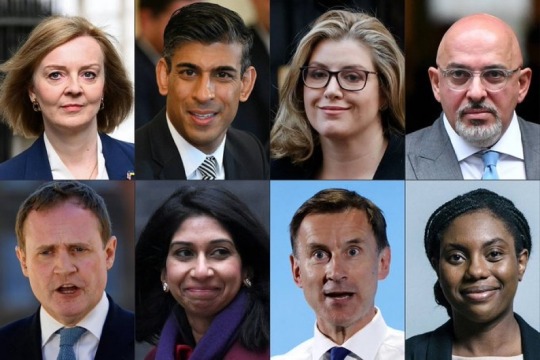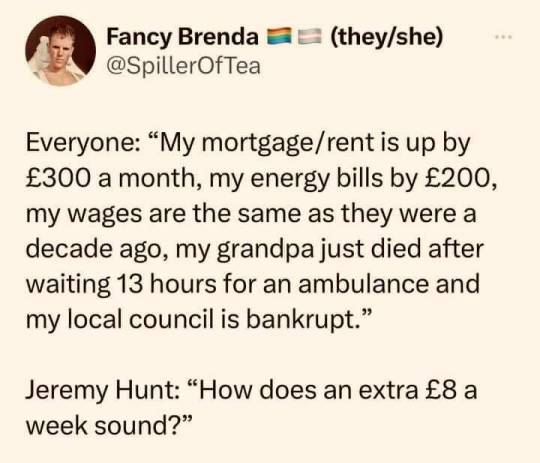#politics of hunting
Text
"In an unprecedented step to preserve and maintain the most carbon-rich elements of U.S. forests in an era of climate change, President Joe Biden’s administration last week proposed to end commercially driven logging of old-growth trees in National Forests.
Secretary of Agriculture Tom Vilsack, who oversees the U.S. Forest Service, issued a Notice of Intent to amend the land management plans of all 128 National Forests to prioritize old-growth conservation and recognize the oldest trees’ unique role in carbon storage.
It would be the first nationwide amendment to forest plans in the 118-year history of the Forest Service, where local rangers typically have the final word on how to balance forests’ role in watershed, wildlife and recreation with the agency’s mandate to maintain a “sustained yield” of timber.
“Old-growth forests are a vital part of our ecosystems and a special cultural resource,” Vilsack said in a statement accompanying the notice. “This clear direction will help our old-growth forests thrive across our shared landscape.”
But initial responses from both environmentalists and the logging industry suggest that the plan does not resolve the conflict between the Forest Service’s traditional role of administering the “products and services” of public lands—especially timber—and the challenges the agency now faces due to climate change. National Forests hold most of the nation’s mature and old-growth trees, and therefore, its greatest stores of forest carbon, but that resource is under growing pressure from wildfire, insects, disease and other impacts of warming.
Views could not be more polarized on how the National Forests should be managed in light of the growing risks.
National and local environmental advocates have been urging the Biden administration to adopt a new policy emphasizing preservation in National Forests, treating them as a strategic reserve of carbon. Although they praised the old-growth proposal as an “historic” step, they want to see protection extended to “mature” forests, those dominated by trees roughly 80 to 150 years old, which are a far larger portion of the National Forests. As old-growth trees are lost, which can happen rapidly due to megafires and other assaults, they argue that the Forest Service should be ensuring there are fully developed trees on the landscape to take their place...
The Biden administration’s new proposal seeks to take a middle ground, establishing protection for the oldest trees under its stewardship while allowing exceptions to reduce fuel hazards, protect public health and safety and other purposes. And the Forest Service is seeking public comment through Feb. 2 (Note: That's the official page for the proposed rule, but for some reason you can only submit comments through the forest service website - so do that here!) on the proposal as well as other steps needed to manage its lands to retain mature and old-growth forests over time, particularly in light of climate change.
If the Forest Service were to put in place nationwide protections for both mature and old-growth forests, it would close off most of the National Forests to logging. In an inventory concluded earlier this year in response to a Biden executive order, the Forest Service found that 24.7 million acres, or 17 percent, of its 144.3 million acres of forest are old-growth, while 68.1 million acres, or 47 percent, are mature."
-via Inside Climate News, December 20, 2023
-
Note: This proposed rule is current up for public comment! If you're in the US, you can go here to file an official comment telling the Biden administration how much you support this proposal - and that you think it should be extended to mature forests!
Official public comments really DO matter. You can leave a comment on this proposal here until February 2nd.
#united states#us politics#conservation#climate change#sustainability#forests#old growth forest#national forest#carbon emissions#climate action#climate crisis#forest service#biden#biden administration#public comment#good news#hope#it took me soooo long to hunt down the actual public comment link#by which I mean like 10 minutes but like#that's too long! especially considering I am way better at navigating language and bureaucratic websites like this#than A LOT of people#why tf can't you just comment on the Official Website For Public Commenting?#aka regulations.gov#baffling#anyway the good news is I did find it so pls do go ahead and submit a comment if you can
3K notes
·
View notes
Text




little moshang fan kid <3
spoiled, aloof, a bit of a bitch, terminally 'weak constitution'-ed, lowkey lazy, prefers reading his dailies in the office and pretending to do paperwork to fighting
#svsss#moshang#he DOES grow up and becomes a respectable demon prince eventually. but hes a cold disinterested spoiled brat as a teen#shang qinghua rides his ass because he KNOWS that hes slacking on the paperwork that hes pretending to do#but unfortunately thats His Baby and he cant be TOO strict (this attitude not extended towards binghe... sad)#crawling out of mirrors like The Grunge to scare the transmigrated soul out of uncle sqq#he got his love of shiny shiny jangly accessories from aunt sha hualing#when he was a baby everyone in court was trying to poison him for political reasons#but didnt realize that since hes only half demon full demon poisons wont kill him#so for years moshang just thought their kid had like. horrible IBS. lack toast and tolerance that almost kills you#and even now as a young man hes like.... ah... sadly my body is too frail to go on ceremonial monster hunts with father..#my greatest love language for a series..... making fankids#his fighting style is Very elegantly avoiding all attacks. poor MBJ like JUST STAND TALL AND TAKE A HIT LIKE A FUTURE DEMON KING#his poor firstborn son like Why would I do that. getting beaten up is very unpleasant. i would personally like to avoid that
505 notes
·
View notes
Text



Solocamping
#pretty little liars#ukpol#british politics#not my king#fuck the monarchy#abolish the monarchy#uk news#camping#hiking#campinggifts#campfire#survival#hunting#outdoors#campinglife#campingsupplies#trendingnow#tumblr trends#tumblrpost#trending
1K notes
·
View notes
Text
By Tayo Bero
This month, the Texas state parole board unanimously recommended the pardon and release of convicted killer and former US army sergeant Daniel Perry, along with the restoration of his firearm rights. Perry had been working as an Uber driver in July 2020 when he shot and killed Garrett Foster, a white man who was attending a Black Lives Matter protest with his Black fiancee. Perry was later indicted for murder, tried, convicted and sentenced to 25 years in prison by an Austin jury.
Almost a year from the date of his sentencing, Perry’s pardon was granted by Texas Governor Greg Abbott, and he now walks free. As terrifying as the initial incident was, this pardon sends a chilling message: that politically motivated killing is OK, and that politicians are more focused on pandering to political pressure than protecting people’s lives.
During Perry’s trial, it emerged that in the weeks before he killed Foster, he had shared white-supremacist memes and talked about how he “might have to kill a few people” who were demonstrating outside his house in 2020. He also compared the Black Lives Matter movement to “a zoo full of monkeys that are freaking out flinging their shit”. And days into nationwide protests sparked by George Floyd’s murder by a Minneapolis police officer, Perry sent a text message saying: “I might go to Dallas to shoot looters.”
Perry described shooting Foster as an act of self-defense. Yet according to trial testimony about the day Foster died, Perry had seen the predominantly Black group of protesters gathered across the street from him, ran a red light and drove his car right into the middle of the protest. When Foster – who was legally carrying a firearm but had not, according to some eyewitnesses, threatened Perry – approached Perry’s car, he shot him dead and sped away.
In rehashing this horrendous incident, the question on my mind is: how do you justify “pardoning” a person like this? Condemning Perry’s release isn’t about believing in carcerality or wanting to keep people in prisons, mind you; it’s about how we get to this point as a society, whom we grant permission to kill, and how we treat the people involved in a tragedy like this in its aftermath.
Abbott – who rarely issues pardons, and has generally only pardoned low-level, nonviolent offenders – had faced pressure from conservative media figures to grant Perry one. Rightwing pundits like former Fox News host Tucker Carlson and even Texas GOP chair Matt Rinaldi squeezed him publicly about Perry’s conviction. It doesn’t seem like Abbott needed much convincing, though, seeing as he directed the parole board to review Perry’s case just one day after he was convicted.
There’s also the question of how we got here. Foster’s death and his killer’s subsequent pardon are the direct result of a government that’s more beholden to wealthy gun lobbyists than concerned with commonsense legislation that literally saves lives. Foster’s death was, in part, the result of a tragic meeting of Texas’s notoriously loose stand-your-ground self-defense laws, which Perry’s supporters claim he was upholding when he shot Foster, and the state’s “open carry” laws, which Foster was legally exercising when he had his rifle slung over his shoulder during the protest.
Alan Bean, the executive director of the Texas-based civil rights advocacy group Friends of Justice, summed up the implications of Perry’s case succinctly.
“If one guy with a gun feels threatened by another guy with a gun, murder is permissible. If both men felt threatened, the resulting tragedy would technically be ruled a no-fault double-homicide,” he wrote after news of the pardon went public.
Even Texas police aren’t blind to the ways that open-carry laws are exceptionally dangerous and nonsensical. “We were completely opposed to ‘license to carry’ because anytime there’s more guns, there’s a problem,” Ray Hunt, executive director of the Houston police officers’ union, said back in 2021.
If there was any doubt that Abbott doesn’t care how problematic these laws are, even after what happened to Foster, consider that he used his pardon announcement to reaffirm that “Texas has one of the strongest ‘stand your ground’ laws of self-defense that cannot be nullified by a jury or a progressive district attorney”.
These are scary words to hear from your elected official after a tragedy that could have been avoided with better gun laws. Abbott continues to signal to gun-toting rightwingers that they can go around murdering people they don’t agree with, and that they will have the full force of the law to back them up.
Foster’s mother, Sheila, spoke to the New York Times after the pardon, and her words are haunting in their truth. “It doesn’t make sense,” she said over the phone. “It seems like this is some kind of a political circus and it’s costing me my life.”
#us politics#news#the guardian#op ed#Tayo Bero#republicans#conservatives#gop#pardons#murder#2020 protests#black lives matter#2024#gov. greg abbott#texas#Daniel Perry#Garrett Foster#stand your ground laws#self defense laws#open carry laws#gun laws#gun control#gun violence#Alan Bean#Ray Hunt
111 notes
·
View notes
Text

he wants to show you his bird
#(if you do not pay respect to the bird you will be poisoned by wang and then gutted by ouyang)#help i have never drawn a horse before. I have been eagle-spotting extensively and yet somehow the horse looks better.#the part in the hunt where ouyang talks about how much esen loves his eagle is so endearing to me.#like. sweet boy. he just wants to hunt and go on campaign surrounded by many many sweaty men and hang out with his Beloved General.#why must you force Politics upon him.#she who became the sun#he who drowned the world#esen-temur#swbts#the radiant emperor#hwdtw#he is so. so. he. he HE#HIM.
282 notes
·
View notes
Text

Whenever anyone tells you that Prince Charles is an environmentalist, just remember he was a very keen fox-hunter and lobbied Tony Blair over the hunting ban.
I cannot stress how much he is only an environmentalist when it suits... e.g. when he wants to oppose development in the countryside.
862 notes
·
View notes
Text

#twitter#andrew bailey#missouri#lgbtqia#trans#trans community#trans ally#politics#social issues#human rights#civil rights#witch hunt#gender identity#genocide#police state#anarchy#anarchist#anarchism#socialism#communism#antigovernment
851 notes
·
View notes
Photo

“Pheasant Shooting in Western Ontario,” Kingston Whig-Standard. October 29, 1932. Page 1.
----
Guns cracked over a 170-miles front in Ontario, October 28, as a two-day pheasant hunt was officially started. This fair Diana shows how it’s done. She's Ruth Yerzy.
[AL: The Ontario pheasant hunt in 1932 was particularly controversial, for a number of reasons. The Ontario government was obviously attempting to limit the hunt to preserve animal numbers, and were draconian against out of season hunters - many of whom were poor men and women during the Depression who desperately needed food. But the hunt itself was accompanied by violence between game wardens and hunters, and between small town and rural locals and the rich tourist hunters, many from Toronto, Hamilton, and other urban centres, who swarmed rural areas, caused a ruckus, and were accused of overhunting. This photo definitely showcases one of the tourist hunters, who were understandably some of the least willing to accede to pheasant quotas during the days of the hunt itself, even when they might support penalizing poachers out of season. This was also one of the first years it was regulated on Pelee Island especially - a popular destination that really concentrated the conflicts here.]
#pheasant#pheasant hunting#gone hunting#hunting season#shooting birds#girl with a gun#great white hunter#wildlife control#exeter county#point pelee#politics of hunting#great depression in canada
2 notes
·
View notes
Note
Hey! I wanted to ask you about how do you feel about fanarts made with your AU? Not going to say names but, some people have already drawn some *suggestive* WH arts with your AU. Does it leave you upset? Should we report it?
Also love your arts,I love how you draw Howdy so fluffly! he's a cutie pie!. I hope you're feeling great!
I mean I don’t mind people making fanart of my au lol, there is already a bunch of people who have made incredible art for it!
I personally do not mind suggestive stuff. H O W E V E R, what I DO mind is if it breaks (other) clowns boundaries. This goes for every single welcome home au out there- just because it’s an au does NOT automatically mean it can randomly subside boundaries. The characters are STILL (other) clown’s property and he has final say on what he wants at the end.
#Welcome home#welcome home mob au#Report/block it if it obviously breaks (other) clown’s boundaries! Or at the very least inform politely#Please don’t witch hunt and bully people btw- it just makes people more likely to retaliate with negativity
653 notes
·
View notes
Photo

#source: twitter#fuck trump#witchcraft#funny tweets#salem#twitter#tweet#trump#politics#seth moulton#witch hunt#occult#dark humor#witch#humor#funny#my shitposts#witchblr#witch aesthetic#meme
364 notes
·
View notes
Text
So, just to summarise
UK Prime Minister Liz Truss fired her Chancellor, replacing him with a man dragged back from political obscurity where he’d languished since his success in uniting the entirety of the NHS in their hatred of him. A man who is his own rhyming slang...
Then her Home Secretary fired off a series of increasingly bizarre and hateful tweets and other public statements, complaining about the police encouraging people to report transphobic hate crimes and [checks notes] how the “tofu-eating, Guardian-reading wokerati” are ruining the UK.
She then did something that broke security protocols and quit with the saltiest resignation letter I’ve seen in a while.
In the meantime, the Health Secretary talked about how she wanted to make antibiotics available over the counter and how she’s often shared “spare” antibiotics with friends. (Incidentally, this is a great way to encourage medically resistant bacteria – diabolical notion.)
Then the Chief Whip resigned. Then unresigned. Apparently. It’s all becoming a bit of a blur.
Then Liz Truss had a big shout in Parliament about how she’s not a quitter.
Then she quit less than 24 hours later.
This is all in the last week, by the way. It’s like a bloody soap opera.
In the meantime, among the potential runners for leader of the Conservative Party we get to include Boris Bloody Johnson who, let’s not forget, lost the confidence of his ministers and party, and still has criminal investigations pending for having partied, presumably using our tax money, while the rest of us stayed away from loved ones to keep them safe.
But it’s okay, because we Got Brexit Done. And Liz Truss, after 44 days in office, gets a £115,000 pension every year FOR LIFE for having been Prime Minister. All this while nurses can’t afford to heat their homes and have to rely on foodbanks to feed their families. Rank obscenity.
To summarise a bit further:
We are SO SCREWED. And a literal lettuce in a wig lasted longer than Liz Truss.
#politics#uk politics#liz truss#kwasi kwarteng#jeremy hunt#suella braverman#thérèse coffey#wendy morton#boris johnson#brexit#prime minister#oc#clownshow
894 notes
·
View notes
Text
can you imagine the amount of pictures with people who became criminals a gotham socialite would have???

#like theres a few rogues who where rich/high paying jobs/ in politics#dc#victor zsasz#veronica vreeland#image#my art#also douglas zsasz is real i had to hunt down a picture of him for this
431 notes
·
View notes
Text

50% are people of colour
50% are women
50% are under 45
50% have a non upper class background
100% of them are ultra right wing bastards
Every single one of these candidates supported Priti Patel’s anti immigration laws.
They’re vocal in their transphobia, making it a main part of their platform.
A lot of them were part of BoJo’s cabinet, which oversaw hundreds of Britons having to choose between heating and food.
They attack those in poverty for relying on benefits but do nothing to stop the living crisis.
The Conservative Party’s leadership race is a brilliant example of how diversity quotas are meaningless if their politics are the all the same.
#Britain#uk politics#politics#rishi sunak#liz truss#tom tugendhat#kemi badenoch#penny mordaunt#Jeremy hunt#nadhim zahawi#suella braverman#boris johnson#conservative party#1k
1K notes
·
View notes
Text
these parallels have haunted me forever and splicing up a video was a lot easier than making a gifset
#tomgreg#tomshiv#tom wambsgans#2x2 vaulter#2x3 hunting#something something shiv is tom is greg... something something real people#tom gets to call greg out for being performative and he's RIGHT#not only in the sense of greg only caring on the surface but also in that he's really trying to help greg move up#and he knows better than anyone that loudly being a Good Person doesn't get you anywhere#meanwhile shiv uses her own performative politics like a weapon and silences tom with them even when he tries to call her out#and it's notable that tom is genuinely much less privileged than her imo#he's trying to live and she's just saying words#and urging him into what winds up being a traumatic situation#meanwhile tom is taking greg to the top#ALSO noteworthy that greg is annoyed at worst and CAN take it#but shiv is like wearing tom's spirit thin#video#mine
133 notes
·
View notes
Text
i've shared some of Alex Freed's narrative writing advice before and i recently read another article on his website that i really liked. particularly in branching/choice-based games, a lot of people often bring up the idea of the author "punishing" the player for certain choices. i agree that this is a thing that happens, but i disagree that it's always a bad thing. i think Freed makes a good case for it here.
...acting as the player’s judge (and jury, and executioner) is in some respects the primary job of a game’s developers. Moreover, surely all art emerges from the artist’s own experiences and worldview to convey a particular set of ideas. How does all that square with avoiding being judgmental?
[...]
Let’s first dispel–briefly–the idea that any game can avoid espousing a particular worldview or moral philosophy. Say we’re developing an open world action-adventure game set in a modern-day city. The player is able to engage any non-player character in combat at any time, and now we’re forced to determine what should occur if the player kills a civilian somewhere isolated and out of sight.
Most games either:
allow this heinous act and let the player character depart without further consequence, relying on the player’s own conscience to determine the morality of the situation.
immediately send police officers after the player character, despite the lack of any in-world way for the police to be aware of the crime.
But of course neither of these results is in any way realistic. The problems in the latter example are obvious, but no less substantial than in the former case where one must wonder:
Why don’t the police investigate the murder at a later date and track down the player then?
Why doesn’t the neighborhood change, knowing there’s a vicious murderer around who’s never been caught? Why aren’t there candlelight vigils and impromptu memorials?
Why doesn’t the victim’s son grow up to become Batman?
We construct our game worlds in a way that suits the genre and moral dimensions of the story we want to tell. There’s no right answer here, but the consequences we build into a game are inherently a judgment on the player’s actions. Attempting to simulate “reality” will always fail–we must instead build a caricature of truth that suggests a broader, more realized world. Declaring “in a modern city, murderous predators can escape any and all consequences” is as bold a statement on civilization and humanity as deciding “in the long run, vengeance and justice will always be served up by the victims of crime (metaphorically by means of a bat-costumed hero).”
Knowing that, what’s the world we want to build? What are the themes and moral compass points we use to align our game?
This is a relatively easy task when working with a licensed intellectual property. In Star Trek, we know that creativity, diplomacy, and compassion are privileged above all else, and that greed and prejudice always lead to a bad end. A Star Trek story in which the protagonist freely lies, cheats, and steals without any comeuppance probably stopped being a Star Trek story somewhere along the line. Game of Thrones, on the other hand, takes a more laissez-faire approach to personal morality while emphasizing the large-scale harm done by men and women who strive for power. (No one comes away from watching Game of Thrones believing that the titular “game” is a reasonable way to run a country.)
These core ideals should affect more than your game’s storytelling–they should dovetail with your gameplay loops and systems, as well. A Star Trek farming simulator might be a fun game, but using the franchise’s key ideals to guide narrative and mechanical choices probably won’t be useful. (“Maybe we reward the player for reaching an accord with the corn?”)
Know what principles drive your game world. You’re going to need that knowledge for everything that’s coming.
[...]
Teaching the player the thematic basics of your world shouldn’t be overly difficult–low-stakes choices, examples of your world and character arcs in a microcosm, gentle words of wisdom, obviously bad advice, and so forth can all help guide the player’s expectations. You can introduce theme in a game the way you would in any medium, so we won’t dwell on that here.
You can, of course, spend a great deal of time exploring the nuances of the moral philosophy of your game world across the course of the whole game. You’ll probably want to. So why is it so important to give the player the right idea from the start?
Because you need the player to buy into the kind of story that you’re telling. To some degree, this is true even in traditional, linear narratives: if I walk into a theater expecting the romcom stylings of The Taming of the Shrew and get Romeo and Juliet instead, I’m not going to be delighted by having my expectations subverted; I’m just going to be irritated.
When you give a player a measure of control over the narrative, the player’s expectations for a certain type of story become even stronger. We’ll discuss this more in the next two points, but don’t allow your player to shoot first and ask questions later in the aforementioned Star Trek game while naively expecting the story to applaud her rogue-ish cowboy ways. Interactive narrative is a collaborative process, and the player needs to be able to make an informed decision when she chooses to drive the story in a given direction. This is the pact between player and developer: “You show me how your world works, and I’ll invest myself in it to the best of my understanding.”
[...]
In order to determine the results of any given choice, you (that is, the game you’ve designed) must judge the actor according to the dictates (intended or implicit) of the game world and story. If you’re building a game inspired by 1940s comic book Crime Does Not Pay, then in your game world, crime should probably not pay.
But if you’ve set the player’s expectations correctly and made all paths narratively satisfying, then there can be no bad choices on the part of the player–only bad choices on the part of the player character which the player has decided to explore. The player is no more complicit in the (nonexistent) crimes of the player character than an author is complicit in the crimes of her characters. Therefore, there is no reason to attempt to punish or shame the player for “bad” decisions–the player made those decisions to explore the consequences with you, the designer. (Punishing the player character is just dandy, so long as it’s an engaging experience.)
[...]
It’s okay to explore difficult themes without offering up a “correct” answer. It’s okay to let players try out deeds and consequences and decide for themselves what it all means. But don’t forget that the game is rigged. [...]
Intentionally or not, a game judges and a game teaches. It shows, through a multiplicity of possibilities, what might happen if the player does X or Y, and the player learns the unseen rules that underlie your world. Embracing the didactic elements of your work doesn’t mean slapping the player’s wrist every time she’s wrong–it means building a game where the player can play and learn and experiment within the boundaries of the lesson.
#every choice you make while designing your game says something about your experiences and your world view#whether you think it does or not#i think abt that interview with hozier where he talks abt all art being political & someone in the comments tried to disagree#by saying a child's drawing of their house cant possibly be political & someone else replies:#but it is. what does a house look like to them? is it one story or two? is it a trailer? an apartment? these things imply something#about that child's lived experience#another post i reblogged on kithj that talked abt these games like the forest or far cry where you play as a random white guy#that is being hunted by the evil native people. and the game requires you to just indiscriminately kill them#without thinking about it bc it's a game and you're the protag. that says something whether it was intentional or not#allowing the player character to do or say certain things without consequences communicates something to the player!!!#this does not mean you should punish them but that you should think about your narrative design and your choices and their outcomes#think about what makes sense in your world#and think about what it could imply in the real world. to the player#and think about all the different paths you can explore with them in this way#writing
70 notes
·
View notes
